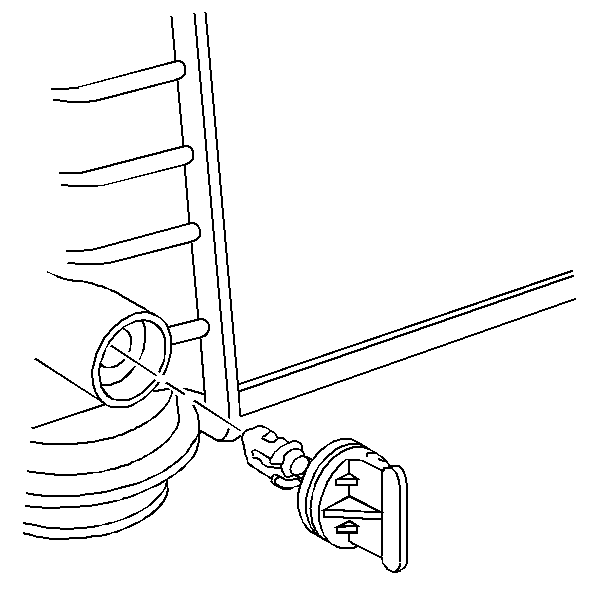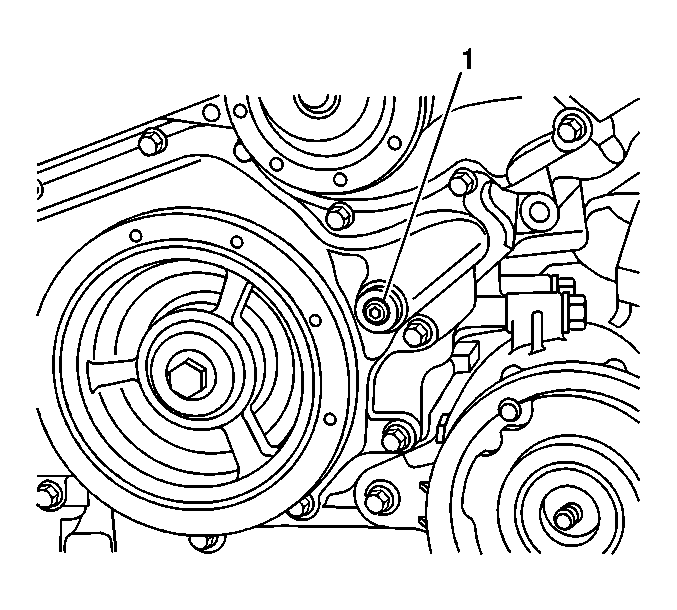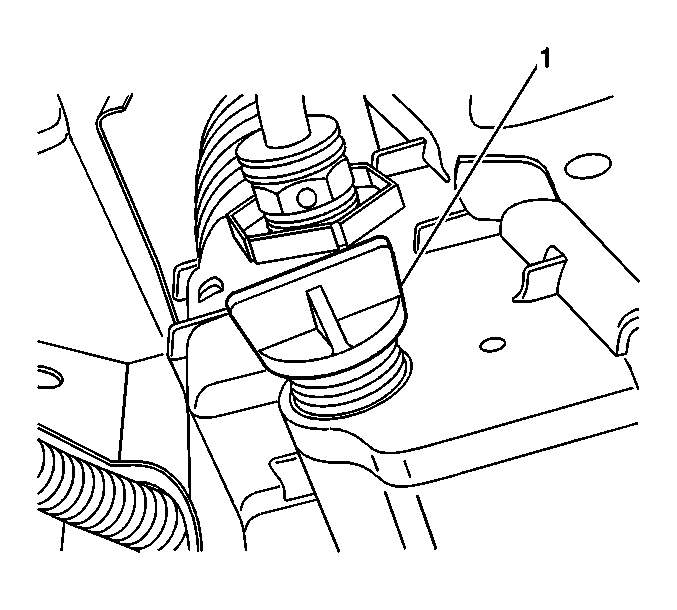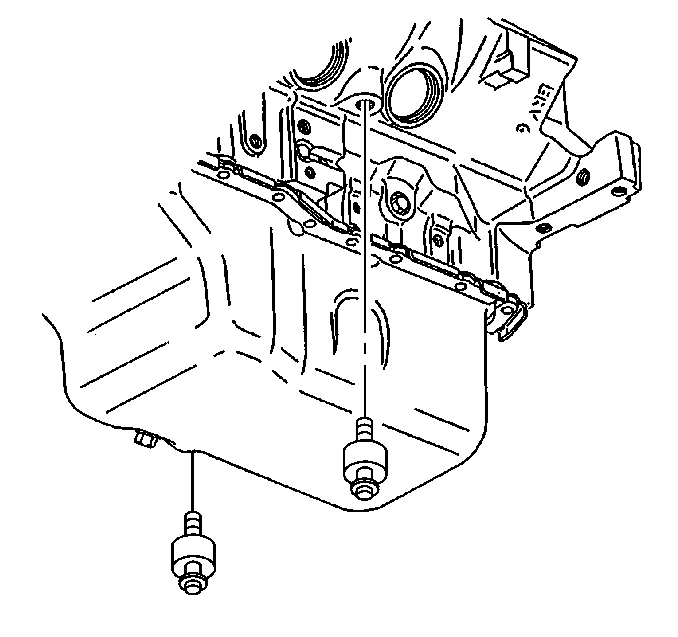Cooling System Draining and Filling 3.5L V6 LX5
Draining Procedure
- Park the vehicle on a level surface.
- Remove the pressure cap when the engine is cool, by:
- Raise and suitably support the vehicle. Refer to Lifting and Jacking the Vehicle in General Information.
- Place a drain pan under vehicle to collect all of the drained coolant.
- Open the radiator drain valve located at the bottom of the radiator tank.
- Remove the right front wheel. Refer to Tire and Wheel Removal and Installation in Tires and Wheels.
- Remove engine block drain plug (1).
- Allow the coolant to drain completely.
| 2.1. | Slowly rotating the cap counterclockwise until a hissing sound is heard. |
| 2.2. | Wait until any residual pressure (indicated by a hissing sound is relieved. |
| 2.3. | After all hissing stops, continue to rotate the pressure cap counterclockwise until the cap is removed. |


Filling Procedure
- Close the radiator drain valve.
- Install the engine block drain plug (1).
- Install the right front wheel. Refer to Tire and Wheel Removal and Installation in Tires and Wheels.
- Remove the drain pan(s) from under the vehicle.
- Lower the vehicle.
- Open the radiator air bleed valve (1).
- Add a 50 percent ethylene glycol DEX-COOL ™ and 50 percent clean drinkable water mixture to fill the system.
- Close the radiator air bleed valve when coolant starts to come out of the air bleed valve (1).
- Slowly add the coolant mixture until the level has reached the FULL COLD mark.
- Run engine to operating temperature while adding coolant/water mixture to FULL mark.
- After engine has reached operating temperature. turn engine off and wait for two minutes and recheck the level of the coolant mixture, add clean water if necessary to restore the coolant mixture level to the FULL COLD mark.
- Install the surge tank cap.
- Inspect the coolant level and freeze protection after the engine completes three thermal cycles (engine heats up to cooling fan operation and cools back down) using a refractometer or a hydrometer to ensure a proper freeze protection of -37°C (-34°F).



Cooling System Draining and Filling 3800 V6 L36
Caution: As long as there is pressure in the cooling system, the temperature can be considerably higher than the boiling temperature of the solution in the radiator without causing the solution to boil. Removal of the pressure cap while the engine is hot and pressure is high will cause the solution to boil instantaneously -- possibly with explosive force -- spewing the solution over the engine, fenders and the person removing the cap.
NOTICE: When adding coolant, it is important that you use GM Goodwrench DEX-COOL® or HAVOLINE® DEX-COOL® coolant. If Coolant other than DEX-COOL® or HAVOLINE® DEX-COOL® is added to the system the engine coolant will require change sooner; at 50 000 km (30,000 mi) or 24 months.
Ethylene glycol/water fill ratios have been established to ensure a minimum of 50 percent ethylene glycol in the coolant flush and drain procedure, and ensuring that all engine block drains and air bleeds were utilized.
The cooling system capacity is 11.6 liters (12.3 quarts). The engine coolant recovery reservoir capacity is 0.65 liters (0.68 quarts) to the COLD mark on the reservoir. The quantities listed in the filling procedure include the additional quantity to displace the air remaining in the engine coolant system after a static refill.
Using the correct fill ratio and the following procedures will ensure a minimum concentration of 50 percent ethylene glycol in the engine coolant system and simplify the customer fill task. Every five years or 240,000 km, (150,000 miles), whichever occurs first, the engine cooling system should be drained and filled using the following recommended procedures.
Draining Procedure
Important: This procedure significantly increases the amount of used engine coolant and diluted hazardous waste.
- Park the vehicle on a level surface.
- Remove and clean engine coolant recovery reservoir.
- Remove the radiator cap when the engine is cool, by:
- Place drain pan under vehicle to collect all drained engine coolant.
- Open the radiator drain valve located at the bottom of the radiator tank.
- Open the air bleed vent (1) on the thermostat housing. The air bleed vent should be opened two to three turns.
- Remove both block drains (Knock Sensors).
- Allow the engine coolant to drain completely.
| 3.1. | Slowly rotating the cap counterclockwise to detent. Do not press down while rotating pressure cap. |
| 3.2. | Wait until any residual pressure (indicated by a hissing sound) is relieved. |
| 3.3. | After all hissing stops, continue to rotate counterclockwise until the cap is removed. |
Important: Recover engine coolant and store in a used coolant holding tank and submit the used engine coolant for recycling on a regular basis. This procedure significantly increases the amount of used engine coolant and diluted hazardous waste.

For procedures requiring the engine cooling system to be partially drained, opening the radiator drain valve should provide sufficient draining and no further actions should be necessary.


Important: Dispose of used engine coolant in a proper fashion, i.e., NEVER POUR USED ENGINE COOLANT DOWN THE DRAIN! Ethylene glycol antifreeze is a very toxic chemical; disposing of it into the sewer system or ground water is both illegal and ecologically unsound!
Filling Procedure
- Close the radiator drain valve. Reinstall all engine block drains.
- Remove the engine coolant recovery reservoir and empty. Flush the reservoir with clean water, drain and reinstall.
- Slowly fill the engine cooling system through the radiator neck using the following procedure:
- Install the radiator cap making certain the arrows line up with the overflow tube.
- Close all air bleeds. DO NOT over-torque the air bleed valve. The air bleed valve is made out of brass.
- Add 0.65 liters (0.68) quarts) of a 50/50 mixture of DEX-COOL™ and clean drinkable water to the engine coolant recovery reservoir.
- Inspect the freeze protection of the engine coolant after the engine heats up and cools down three times using a refractometer or a thermohydrometer to ensure proper freeze -37°C (-34°F) protection. Obtain the engine coolant mixture for the inspection from the base of the radiator neck, NOT from the engine coolant recovery reservoir.

Important:
• When refilling the engine coolant system, add GM approved new
Ethylene Glycol Coolant DEX-COOL™. • If the engine cooling system is being refilled ONLY (no flush),
a 50 percent DEX-COOL™ and 50 percent clean drinkable water mixture
should be used to fill the system. Fill the system until the level of the
50/50 mixture has reached the base of the radiator neck. Wait two minutes
and recheck the level of the engine coolant mixture, add a 50/50 DEX-COOL™/clean
drinkable water mixture as necessary to restore the engine coolant mixture
level to the base of the radiator neck.
| 3.1. | If the engine coolant system has been flushed first add 100 percent DEX-COOL™ in the amount listed in the graphic for the appropriate engine application. |
| 3.2. | Slowly add clean drinkable water to the system until the level of the engine coolant mixture has reached the base of the radiator neck. |
| 3.3. | Wait for two minutes and recheck the level of the engine coolant mixture, add clean drinkable water if necessary to restore the engine coolant mixture level to the base of the radiator neck. |
Notice: The Low Coolant warning/indicator lamp may come on after this procedure. If after operating the vehicle so that the engine heats up and cools down three times, the Low Coolant warning/indicator lamp does not go out, or fails to come on at the ignition check, and the coolant is above the full cold mark in the reservoir, refer to Low Coolant Warning/Indicator Lamp in Electrical Diagnosis. If at any time the Temperature warning/indicator lamp comes on, immediate action is required. Turn OFF the engine and allow the vehicle to cool. Do not remove the coolant recovery reservoir cap at this time.
